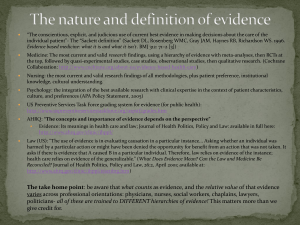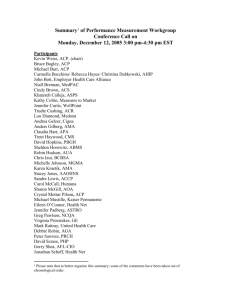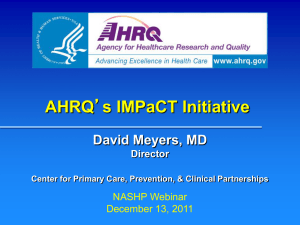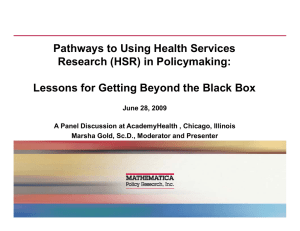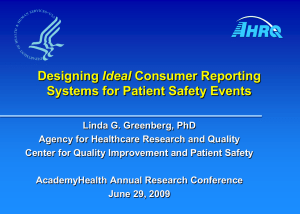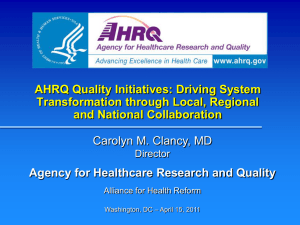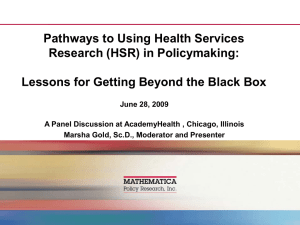6 om as a public service of the RAND Corporation.
advertisement
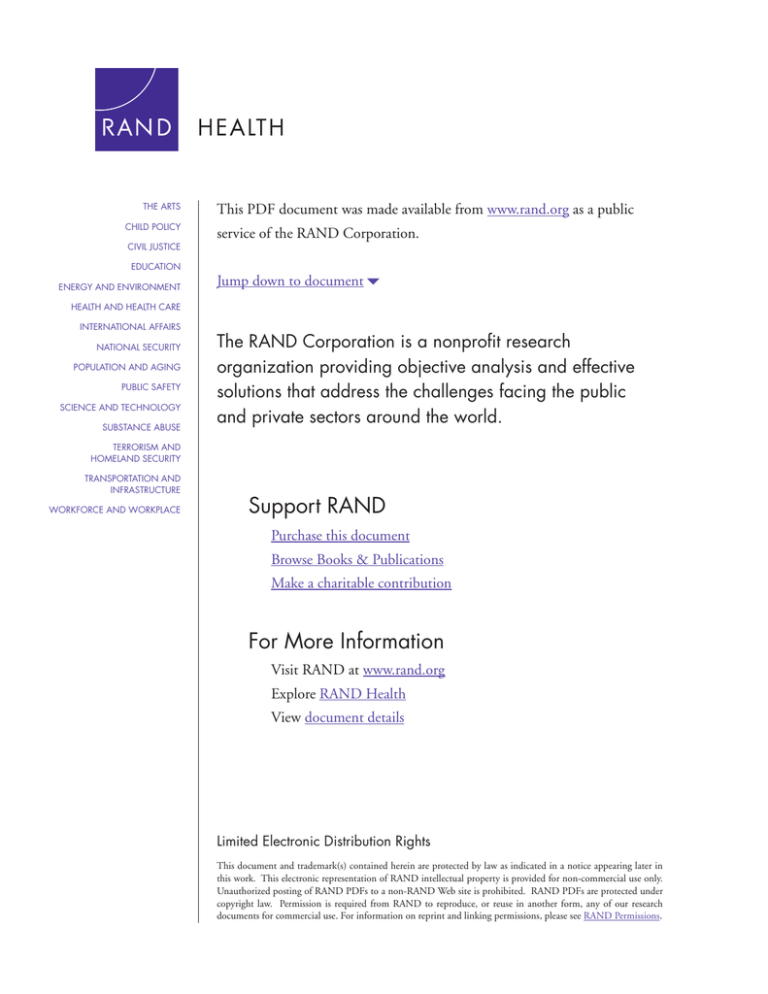
THE ARTS CHILD POLICY CIVIL JUSTICE EDUCATION ENERGY AND ENVIRONMENT This PDF document was made available from www.rand.org as a public service of the RAND Corporation. Jump down to document6 HEALTH AND HEALTH CARE INTERNATIONAL AFFAIRS NATIONAL SECURITY POPULATION AND AGING PUBLIC SAFETY SCIENCE AND TECHNOLOGY SUBSTANCE ABUSE The RAND Corporation is a nonprofit research organization providing objective analysis and effective solutions that address the challenges facing the public and private sectors around the world. TERRORISM AND HOMELAND SECURITY TRANSPORTATION AND INFRASTRUCTURE WORKFORCE AND WORKPLACE Support RAND Purchase this document Browse Books & Publications Make a charitable contribution For More Information Visit RAND at www.rand.org Explore RAND Health View document details Limited Electronic Distribution Rights This document and trademark(s) contained herein are protected by law as indicated in a notice appearing later in this work. This electronic representation of RAND intellectual property is provided for non-commercial use only. Unauthorized posting of RAND PDFs to a non-RAND Web site is prohibited. RAND PDFs are protected under copyright law. Permission is required from RAND to reproduce, or reuse in another form, any of our research documents for commercial use. For information on reprint and linking permissions, please see RAND Permissions. This product is part of the RAND Corporation technical report series. Reports may include research findings on a specific topic that is limited in scope; present discussions of the methodology employed in research; provide literature reviews, survey instruments, modeling exercises, guidelines for practitioners and research professionals, and supporting documentation; or deliver preliminary findings. All RAND reports undergo rigorous peer review to ensure that they meet high standards for research quality and objectivity. Assessment of the AHRQ Patient Safety Initiative Focus on Implementation and Dissemination Evaluation Report III (2004–2005) Donna O. Farley, Cheryl L. Damberg, M. Susan Ridgely, Melony E. Sorbero, Michael D. Greenberg, Amelia Haviland, Robin C. Meili, Stephanie S. Teleki, Lily Bradley, Jacob W. Dembosky, Allen Fremont, Teryl K. Nuckols, Rebecca Shaw, Stephanie L. Taylor, Hao Yu Prepared for the Agency for Healthcare Research and Quality HEALTH This work was prepared for the Agency for Healthcare Research and Quality under contract No. 290-02-0010. The research was conducted in RAND Health, a division of the RAND Corporation. Library of Congress Cataloging-in-Publication Data Assessment of the AHRQ patient safety initiative : focus on implementation and dissemination evaluation report III (2004–2005) / Donna O. Farley ... [et al.]. p. cm. The third annual evaluation report covering the period from October 2004 through September 2005, which builds upon two previous evaluation reports covering the periods from October 2002 through September 2003 and from October 2003 through September 2004, respectively. Includes bibliographical references. ISBN 978-0-8330-4217-0 (pbk. : alk. paper) 1. Medical errors—Prevention—Government policy—United States. 2. Iatrogenic diseases—Prevention— Government policy—United States. 3. Patients—United States—Safety measures. I. Farley, Donna. II. Title: Assessment of the Agency for Healthcare Research and Quality patient safety initiative. [DNLM: 1. Medical Errors—prevention & control—United States. 2. Data Collection—United States. 3. Government Programs—United States. 4. Information Dissemination—United States. 5. Outcome and Process Assessment (Health Care)—United States. 6. Program Evaluation—United States. WB 100 A838 2007] R729.8.A872 2007 610—dc22 2007037735 The RAND Corporation is a nonprofit research organization providing objective analysis and effective solutions that address the challenges facing the public and private sectors around the world. RAND’s publications do not necessarily reflect the opinions of its research clients and sponsors. R® is a registered trademark. © Copyright 2007 RAND Corporation All rights reserved. No part of this book may be reproduced in any form by any electronic or mechanical means (including photocopying, recording, or information storage and retrieval) without permission in writing from RAND. Published 2007 by the RAND Corporation 1776 Main Street, P.O. Box 2138, Santa Monica, CA 90407-2138 1200 South Hayes Street, Arlington, VA 22202-5050 4570 Fifth Avenue, Suite 600, Pittsburgh, PA 15213-2665 RAND URL: http://www.rand.org To order RAND documents or to obtain additional information, contact Distribution Services: Telephone: (310) 451-7002; Fax: (310) 451-6915; Email: order@rand.org EXECUTIVE SUMMARY As of October 2005, it has been four years since the U.S. Congress funded the Agency for Healthcare Research and Quality (AHRQ), in the Department of Health and Human Services (DHHS), to establish the national patient safety research and implementation initiative. AHRQ contracted with the RAND Corporation in September 2002 to serve as the evaluation center for this initiative. This report—Evaluation Report III—is the third of four annual evaluation reports to be prepared by the evaluation center. It covers the period from October 2004 through September 2005. It updates information on the current status of the AHRQ patient safety initiative and examines progress in carrying out the component activities that were identified in Evaluation Reports I and II (Farley et al., 2005; Farley et al., 2007). The recommendations we offer are intended as suggestions to help guide the agency’s future strategy and activities, and they are focused on actions that AHRQ is in a position to take. In some cases, we reiterate suggestions from earlier evaluation reports; in other cases, we offer new suggestions or extensions of previous ones, based on findings from the most recent evaluation analyses conducted in 2004– 2005. (See the Appendix for suggestions for AHRQ action presented in the previous two reports.) EVALUATION FRAMEWORK In early 2000, the Institute of Medicine (IOM) published the report To Err Is Human: Building a Safer Health System, calling for leadership from DHHS in reducing medical errors and identifying AHRQ as the lead agency for patient safety research and practice improvements. Mandated by the U.S. Congress to lead federal patient safety improvement activities, AHRQ can provide motivation and guidance for the activities of others and, by integrating its work with that of other organizations in both public and private sectors, it can leverage finite resources and achieve synergy through collaboration. The Evaluation Model The overall evaluation design is based on the Context-Input-Process-Product (CIPP) model, which is a well-accepted strategy for improving systems that encompasses the full spectrum of factors involved in the operation of a program (Stufflebeam et al., 1971; Stufflebeam, Madaus, and Kellaghan, 2000). The core model components are represented in the CIPP acronym: x Context evaluation assesses the circumstances stimulating the creation or operation of a program as a basis for defining goals and priorities and for judging the significance of outcomes. x Input evaluation examines alternatives for goals and approaches for either guiding the choice of a strategy or assessing an existing strategy against the alternatives. x Process evaluation assesses progress in implementing plans relative to the stated goals for future activities and outcomes. x Product evaluation identifies consequences of the program for various stakeholders, intended or otherwise, to determine the effectiveness of and provide information for future program modifications. xi A Framework for the Process Evaluation The process evaluation is the largest and most complex component of the evaluation because many aspects of the health system are affected by AHRQ’s work and that of numerous other organizations involved in patient safety. We adopted a national perspective, the goal of which was to assess the progress of the AHRQ initiative and the activities of other agencies and organizations in the context of the larger U.S. patient safety system. We identified five system components that are essential to bringing about improved practices and a safer health care system for patients. Together, these components provide a cohesive framework for the process evaluation. They work together to bring about improved practices and a safer health care system for patients, as shown in Figure S.1. The components are (1) monitoring progress and maintaining vigilance; (2) establishing knowledge of the epidemiology of patient-safety risks and hazards; (3) developing effective practices and tools; (4) building infrastructure for effective practices; and (5) achieving broader adoption of effective practices. Our process evaluation examined progress in strengthening each of these components. Knowledge development Knowledge of Epidemiology of Patient Safety Risks and Hazards Practice implementation Building Infrastructure for Effective Practices Development of Effective Practices and Tools Achieving Broader Adoption of Effective Practices Monitoring Progress and Maintaining Vigilance Figure S.1 The Components of an Effective Patient Safety System The component for monitoring progress and maintaining vigilance is identified first and placed on the bottom left side of the figure, reflecting the need for early data on patient safety issues to help guide intervention choices, as well as ongoing feedback regarding progress in developing knowledge and implementing practice improvements. The top row of the figure contains the two components that contribute to knowledge development regarding patient-safety epidemiology and effective practices and tools. This knowledge is then used in the remaining two model components, which contribute to practice implementation—building infrastructure and adopting effective practices (in the second row of the figure). FINDINGS FROM THE CONTEXT AND INPUT EVALUATIONS Context Evaluation The AHRQ patient safety initiative was designed within a policy context that created high expectations for achieving patient safety improvements. In Evaluation Report I, we identified the following implications for AHRQ, which continue to be relevant in 2005: xii x AHRQ leadership—a clear mandate by Congress for AHRQ to provide leadership in effecting change in patient safety practices. x Balance between research and implementation—the need for AHRQ to balance its traditional role of funding health services research with a shift to an implementation focus, to catalyze patient safety improvement in the health care system. x Resource constraints—small appropriation of funding relative to the work at hand, including research to strengthen knowledge and actions to bring that knowledge to the health care community and increase adoption of safer practices. x Accountability for results—high expectations by Congress that AHRQ demonstrates progress in improving patient safety practice and reducing harm to patients. x Coordination of multiple activities—a diversity of patient safety activities undertaken by multiple public and private organizations, which requires a coordination role for AHRQ to achieve synergy among them and to encourage consistent standards of practice. Over the past year, several new developments have raised the level of attention to patient safety, with a particular focus on using health information technology (health IT) to achieve safer care. These developments include: appropriations by Congress in September 2004 to support health IT projects ($50 million) and development of health IT standards ($10 million); the enactment of the Patient Safety and Quality Improvement Act of 2005 (Public Law 109-41) in July 2005, which the Secretary of the DHHS tasked AHRQ to implement; the development of other public- and private-sector initiatives to improve patient safety; and recent critiques of the progress of patient safety improvement. Input Evaluation During FY 2004, AHRQ continued the overall agency management and focus that it established in the preceding year. These include its mission and strategic plan aimed at achieving quality improvement in the health care system, work portfolios that integrate the agency’s activities by topic area, and goals and objectives for the patient safety initiative. AHRQ established the Patient Safety Research Coordinating Center (Coordinating Center) at the start of the patient safety initiative, which serves as a stimulus and facilitator of interactions among the projects funded under the initiative. A new contract was awarded in FY 2004, under which the Coordinating Center places much greater emphasis on dissemination and implementation activities and also supports broader patient safety activities within the agency. AHRQ also established a National Resource Center for Health Information Technology (Resource Center) in FY 2004, which provides technical assistance and support for the health IT grantees and assists AHRQ with managing the health IT program. Cumulative funding for patient safety projects has generated a substantial body of work since FY 2000. The five systems-related best practices (SRBP) grants were funded in FY 2000, followed by 81 patient safety projects funded in FY 2001. The 13 patient safety challenge grants were funded in FY 2003, and 108 health IT grants and contracts were funded in FY 2004. In FY 2005, 17 grants for Partnerships in Implementing Patient Safety (PIPS) were funded, as were 16 new health IT grants and contracts. As the patient safety initiative moved forward in FY 2004–FY 2005, AHRQ expanded its focus to include an emphasis on dissemination activities and support of implementation-oriented projects. At the same time, large field-based initiatives led by other organizations were xiii reinforcing the dissemination of proven patient safety practices among health care providers. Within this policy and operational context, AHRQ should consider taking several categories of actions as it directs the future of the initiative: x x x x Engage proactively to disseminate patient safety practices. Collaborate actively in initiatives sponsored by others. Focus on establishing a national patient safety data network. Plan for future patient safety spending priorities. ISSUES AND ACTION OPPORTUNITIES FROM THE PROCESS EVALUATION Monitoring Progress and Maintaining Vigilance (Chapter 3) AHRQ faces both opportunities and challenges in bringing about a national patient safety data network, which we have identified as a priority since the first year of the evaluation. The passage of the Patient Safety and Quality Improvement Act of 2005 (PSQIA) shifted the balance toward opportunity, because it provides for development of a network of databases as part of the larger patient safety organization (PSO) program, which offers confidentiality protections that should encourage reporting by providers. Challenges remain, however, especially in the need to reach consensus among diverse stakeholders to achieve consistency in both the measures being entered into data systems and standards for those systems. The Institute of Medicine report Patient Safety: Achieving a New Standard of Care (IOM, 2004) offers a useful starting point for standard development, but the responsibility for providing direction so that one set of standards can emerge probably will rest with federal agencies. AHRQ’s leadership can be applied to stimulate dissemination and adoption of these standards, including close work with end users to ensure that the system designs are in fact serving their needs. We encourage AHRQ to remain flexible in seeking ways to establish a viable national patient-safety data repository, responding to new standards or tools that arise in the field of health IT and making full use of relevant products from the earlier AHRQ-funded projects. AHRQ also should place a priority on further development of patient safety measures that could apply to aspects and settings of care for which measures do not yet exist—in particular, ambulatory care and long-term care settings. Suggestions for AHRQ Action x AHRQ should continue to pursue the goal of developing a national-level patient safety data capability in which multiple public and private users participate, with reinforcement by provisions in the newly enacted patient safety legislation for voluntary reporting by patient safety organizations into a network of patient safety databases. x Using a structured consensus process involving multiple stakeholders, AHRQ should place a priority on building on the existing Patient Safety Indicators to establish a broader set of national patient safety measures that represents the most important safety aspects of the patient’s health care experience in a variety of settings. Knowledge of Epidemiology and Development of Effective Practices (Chapter 4) The two components encompassed in the Knowledge Development portion of the patient safety system (Figure S.1) are addressed in one chapter, reflecting their interrelatedness as well as a shift in emphasis of the overall patient safety initiative, away from focusing on changes in xiv knowledge of epidemiology (what are the safety issues) toward expanded development and testing of new safety practices (how to improve safety). We examine updated information on publications addressing epidemiology of patient safety risks and the contributions of AHRQfunded projects to this information. We then assess the potential contributions to knowledge of the three sets of new health IT grants that AHRQ funded in FY 2004, totaling 104 projects, as part of our ongoing assessment of new patient safety projects as AHRQ funds them. The existing patient safety grants have been producing a fast-growing literature on patient safety epidemiology, which can help decisionmakers assess future priorities. At the same time, the health IT projects, as with AHRQ’s other patient safety projects, are addressing a diversity of patient safety issues and have the potential to contribute new knowledge and additional scientific evidence for new patient safety practices. According to reports from the health IT grantees, the funding that AHRQ has provided to them is making a significant contribution to the diffusion and adoption of health IT across a range of health-care practice settings. The partnerships across communities developed in these projects, and lessons learned by the grantees in working with them, can serve as guidance for others in enhancing their adoption of health IT. Not surprisingly, the early experiences of the health IT projects revealed many of the same design and implementation issues identified by previous patient safety projects. They also raised numerous other issues related specifically to use of IT systems. This information is valuable for other organizations embarking on similar projects. It also can help the Resource Center to fine-tune its technical support for the grantees. Suggestions for AHRQ Action x AHRQ should maintain an ongoing monitoring process that uses data from the national network of patient safety databases, as well as published research, to examine shifts in trends for patient safety epidemiology in specific aspects of health care and to identify emerging safety issues that need to be addressed to ensure the safety of health care practices. x AHRQ and the Resource Center should establish a structured program of start-up support and training to first-time grantees to help them understand their responsibilities and AHRQ’s expectations. x AHRQ should encourage and support work on development of flexible, inexpensive, IT solutions that are accessible for low-resource and rural organizations. x AHRQ should explore mechanisms to strengthen the evaluation component of the health IT implementation projects, such as providing more evaluation technical assistance, requiring that grantees partner with evaluation researchers; or having the evaluation component be conducted independently from the health IT implementation. x AHRQ should work with the Resource Center to clarify to grantees the functions of the Resource Center and the type of technical assistance it can provide to grantees, and to tailor technical assistance on evaluation measures and methodologies to the unique features of local projects. x In partnership with other relevant federal agencies, AHRQ should develop clear federal guidance on standards and other requirements for interoperability of health IT, making the investment in health IT more compelling and easier for low-resource organizations. xv Building Infrastructure for Effective Practices (Chapter 5) Our evaluation identified patient safety culture, information systems, adverse-eventreporting systems, interdisciplinary teams, multi-institutional collaborations, and qualityimprovement systems and measures as key components for a patient safety infrastructure. Our assessment of ARHQ’s contribution to each of these components has found that, thus far, ARHQ has made its strongest contributions to building patient safety culture, information systems, adverse-event-reporting systems, and multi-institutional collaborations. It has done so through the types of patient safety projects it has funded, its partnership outreach with other organizations, its specific initiative for high-reliability organizations, dissemination of the Hospital Survey on Patient Safety Culture, the new Accelerating Change and Transforming Organizations and Networks (ACTION) and Developing Evidence to Inform Decisions About Effectiveness (DEcIDE) networks, and other network programs. In addition, our analyses have found that the Patient Safety Improvement Corps (PSIC) has stimulated actions by its participants to implement patient safety improvements in their respective organizations. In considering what more needs to be done to ensure the establishment of effective infrastructures for patient safety practices in the health care system, it will be important to assess not only AHRQ’s contributions but also those of other organizations that have been undertaking similar actions at the national, regional, and local levels. New work currently under way by AHRQ includes development of products for health care providers to strengthen interdisciplinary teams, which it plans to introduce in FY 2006, and work to strengthen quality-improvement systems and measures. Continued work also is needed for already-established programs. The Hospital Survey on Patient Safety Culture, if used widely by hospitals across the country, could have far-reaching effects on performance. We note that hospitals (or other organizations) using the culture survey need to use the information it generates to guide actions for changing practices and attitudes, to ultimately achieve a strong safety culture. It is critical for AHRQ to capture information on the use of the survey and resulting improvement activities by hospitals, so that the effect of the survey can be documented and assessed. The first two years of the PSIC have demonstrated the value of bringing together groups of diverse stakeholders and of providing them with intense patient safety training. With completion of the training for a third group of participants in May 2006, the original goal and scope of the PSIC will have been achieved. However, the very success of this PSIC scope of work raises questions about how to establish a sustainable infrastructure for building on the expertise and partnerships it has fostered thus far. AHRQ and the Department of Veterans’ Affairs (VA) face some important decisions regarding how to approach the next generation of PSIC activities, including options for a train-the-trainer program, continued support of patient safety activities by PSIC graduates, and strategies to reach health care decisionmakers who ultimately determine how far these activities can proceed. In considering future options for building infrastructure, AHRQ will need to choose strategically where to invest its limited resources. Engaging in partnerships is a useful strategy to leverage resources, but AHRQ will need to decide which types of partnerships might be the most fruitful to lead, and which are better led by other organizations. The new AHRQ network initiatives for high-reliability organizations, ACTION, and DEcIDE offer rich potential to contribute to the patient safety infrastructure. We encourage AHRQ to monitor these programs regularly, seeking feedback from participants, and gathering information to learn from experience and modify the programs as needed. xvi Suggestions for AHRQ Action x As AHRQ continues to work with hospitals to support their use of the Hospital Survey on Patient Safety Culture, it should establish a structured monitoring process that collects data on trends in hospital use of the survey, issues identified by hospitals from survey data, and actions hospitals take to respond to those issues. x Building upon the successful PSIC training that has reached the front-line hospital and state-level staff, AHRQ should work with relevant organizations to stimulate outreach to increase commitment to patient safety by key decisionmakers who are needed to make patient safety improvements happen. x AHRQ should assist PSIC graduates in finding support for their continued engagement in patient safety issues, updating their skills and knowledge, and encouraging synergy among the PSIC graduates and with others in the field. x If AHRQ and the VA pursue a PSIC train-the-trainer program, it should be a working partnership among AHRQ, the VA, and the trainers to ensure that the persons who become trainers have the needed teaching skills to fulfill the defined trainer role. Achieving Broader Adoption of Effective Practices (Chapter 6) To guide our assessment of AHRQ’s progress in dissemination of new safe practices and tools, we developed a framework that identifies AHRQ as a change agency—an entity that works to disseminate new practices (innovations) for adoption in the field. This framework also identifies four phases of action by change agencies: problem recognition and assessment, development of usable innovations, packaging of innovations, and dissemination and diffusion of innovations (see Figure 6.1 and Table 6.1). We found that AHRQ has done extensive work in the problem recognition and assessment phase of the dissemination process. However, its activities for the remaining phases thus far have occurred on a relatively small scale. Although its dissemination activities have grown (e.g., packaging and dissemination of the AHRQ patient safety culture survey and packaging products from the Partnerships in Implementing Patient Safety grants), AHRQ has made slow progress in both the development and packaging of innovations and the dissemination of those innovations. AHRQ has yet to implement a comprehensive strategy for dissemination of patient safety practices and tools, owing to several factors, including difficulties in getting complete information from grantees on their project products and findings, and it has a tendency to emphasize communications rather than product packaging and dissemination for end users. In addition, end users have not yet had much involvement in AHRQ’s process for establishing priorities for products and tools. At the same time, initiatives for implementing proven patient safety practices have been mobilizing in the field with increasing speed. Recent national initiatives, which are attracting participation by hundreds of hospitals across the country, show that commercialization of proven patient safety products is happening in the field, which may be the best place for that work to be done. These initiatives include the Surgical Care Improvement Project (SCIP) led by the Centers for Medicare and Medicaid Services (CMS), the 100,000 Lives (now the 5 Million Lives) Campaign led by the Institute for Healthcare Improvement (IHI), and hospital transformation work by the Quality Improvement Organizations (QIOs). AHRQ will need to be able to move quickly to match the pace of these initiatives and serve as a useful resource to them. Given this context of strong and growing activities by end users, AHRQ should focus its efforts where it offers unique capability to make the best contributions to the dissemination of xvii patient safety practices. Although AHRQ is viewed by end users as the leader in patient safety research and knowledge, the agency is not an organization on the front line of health care delivery—which is where changes in practices need to occur to improve safety. We suggest that foremost among the unique contributions AHRQ can make will be the new knowledge and products from its patient safety projects, including establishment of priorities for patient safety actions based on syntheses of this information. A complementary contribution is service by AHRQ as a national clearinghouse for patient safety information, including results from AHRQfunded research, products and tools for safe practices, and linkages to information provided by field-based organizations and initiatives. Suggestions for AHRQ Action x AHRQ should develop and implement a strategic plan that defines its focus on and roles for disseminating new patient-safety knowledge and products, with support for this work coming from an appropriate internal infrastructure and budget. x As AHRQ continues to partner with health care systems and other implementers on dissemination activities, it should place a priority on synthesizing information and packaging products and tools from the patient safety grantees so that this information can be available to the field in a usable and timely manner. x Building on its strength as a national information resource on the scientific basis of patient safety issues and practices, AHRQ should extend its work to further establish the Patient Safety Net (PSNet) as an integrated clearinghouse on patient safety, including linkages to information provided by other organizations, that is the “go-to” place for users across the country. PRODUCT EVALUATION: PATIENT SAFETY OUTCOMES Analysis of baseline trends in outcomes is a necessary first step in exploring the effect of AHRQ’s patient safety activities, which is the work of the product evaluation (see CIPP definition above). We have defined the baseline period to be the late 1990s through 2003, which immediately precedes the time during which actions undertaken through the AHRQ patient safety initiative should begin to influence patient safety outcomes. Data for more-recent years will begin to become available by 2006, and these data can be used to assess whether early effects of patient safety activities are observable in trends for the patient-outcome measures. In preparation for this assessment, exploratory analysis of patient-safety-outcome measures was performed using data from other organizations and our own analyses of encounter data. These analyses served three purposes: (1) provide information for health care providers, policymakers, standard-setting organizations, and other stakeholders regarding historical performance for selected safety outcome measures; (2) identify measurement and methodological issues that needed to be addressed to ensure the validity of the trend data used to assess effects; and (3) serve as the basis for estimating linear baseline trend lines to which future values for the measures can be compared. Several highlights emerged from the analyses of trends in reported events and rate measures (i.e., with denominators), which will be considered as the product evaluation moves forward. Perhaps the most obvious one is the large differences in the trends observed for the reported events and measures that are rates. Occurrences of reported events have increased over time for both the Joint Commission sentinel events and the MedMARx adverse medication xviii events. By contrast, trends in rate measures generally have changed more gradually, some moving up and others moving down, and rates for some measures have not changed at all. For each type of measure, we identified specific issues that will affect their usability for national-level monitoring. For reported-event measures, it will be important to isolate independent effects on observed rates by underreporting of events, increased reporting as patient safety vigilance increases, and subsequent reductions in reported events as safety practices improve. For measures based on rates, trends vary across measures and over time, so it will be essential to select carefully the measures used to monitor changes in outcome rates to ensure that, as a group, they fulfill the function of serving as proxies for larger performance trends across a health care setting. In addition, it will be important to use multiple years to establish baseline trend data, which brings with it the challenge of adjusting estimates for changes in definitions for diagnosis codes, as well as in methods for calculating the measures using them. Our examination of baseline trends in patient safety outcomes identified some important opportunities for future action by AHRQ. Ambulatory care settings are perhaps the highest priority for a development effort, but even currently existing hospital claims-based measures and datasets can benefit from additional refinement, expansion, and validation. In year four, we will expand on the work presented here by exploring the initial effects of AHRQ’s activities on patient safety outcomes. We also will examine some additional sources of patient-safety process and outcomes data, and will make further efforts to contribute to the development of patient safety measures across a range of health care settings and procedures. Suggestions for AHRQ Action x AHRQ should harmonize and validate the capture of claims information in existing inpatient claims databases (in collaboration with CMS and other organizations), by evaluating the consistency of claims-coding practices across hospitals and regions, and by adding to the MCBS claims files the data needed to estimate patient safety measures. x AHRQ should place a priority on developing a set of patient safety measures for ambulatory care settings, and it should foster the establishment of a data infrastructure that can support measurement for ambulatory-care patient-safety issues. x AHRQ should work collaboratively to establish an infrastructure and procedures for regular collection of data on the use of effective patient-safety tools and practices by health care organizations, for inclusion in the national network of databases, along with reports from the organizations about the effects of those tools and practices on care processes and clinical outcomes. NEXT STEPS The evaluation results presented in Evaluation Report III have focused on the process and product evaluations performed in 2004–2005. This phase of the evaluation focused on the initiative’s contributions to each of the five system components (Figure S.1), including assessment of potential contributions of the health IT projects to patient safety knowledge and practices and AHRQ’s progress in activities to disseminate proven patient safety practices for broad adoption by health care providers. We also developed baseline trends for selected measures to assess effects of the initiative on patient outcomes and other stakeholders. In addition, the activities of field-based initiatives (e.g., 5 Million Lives Campaign; see Chapter 6) xix have become subjects for the evaluation, because they are important vehicles for the diffusion of safe practices across the health care system, and AHRQ is partnering in them as part of its dissemination strategy. The progress of AHRQ’s patient safety initiative in the five years since the publication of the IOM report To Err Is Human (IOM, 2000) can be summarized with respect to each of the five system components on which we organized our process evaluation. The greatest progress has been in the contributions made to development of knowledge of patient safety epidemiology and effective practices, through the patient safety projects it has funded each year, as well as to development or strengthening of infrastructure to support adoption of safety practices. The components for which progress has been slower are the establishment of a monitoring and vigilance capability and the dissemination of knowledge and products into the field for use by health care providers and other end users. The activity mix of the patient safety initiative has been shifting, as AHRQ has increased its emphasis on the synthesis of knowledge and packaging of products emerging from its funded projects, along with packaging and dissemination of products and tools for adoption by health care providers. With small funding relative to the size of the national patient safety problem, however, the potential for AHRQ to have an effect on creating a safer health care system may be limited. Recognizing its funding constraints, AHRQ has been using a variety of approaches to leverage resources, such as cost sharing on implementation projects and working through partners. Results from the FY 2000–FY 2001 projects, which are entering the published literature rapidly, will need to be synthesized to provide the information base for the dissemination and adoption strategies. Other AHRQ activities—such as the PSIC and the hospital culture survey— have come to maturity and are beginning to build infrastructure and influence patient safety practices across the country. Its most recently funded grant projects are addressing health IT and implementing patient safety practices, thereby continuing to build knowledge and evidence to support practice improvements. Achieving the goal of a safer health care system will depend on the commitment of thousands of organizations, with leadership and support from agencies such as AHRQ and other government agencies. The momentum of widespread participation by providers in field-based initiatives has become highly visible this year, which bodes well for diffusion of safer practices. The enactment of the PSQIA has created another important mechanism that makes it safer for providers to report adverse events and work to prevent them, and it provides a much-needed stimulus for establishment of a national patient safety data repository. From our observations of AHRQ’s patient safety strategy, and in view of the current activities of its grantees and field organizations, we have identified several priorities that we encourage ARHQ to pursue in the near future: x Facilitate movement toward a national network of patient safety databases by using the provisions in the Patient Safety and Quality Improvement Act of 2005 to encourage use of consistent data standards, and establish a set of national patient safety measures for assessing performance. x Identify key patient safety practices and products from the results of the FY 2000–FY 2001 patient safety projects by synthesizing results from groups of projects addressing similar issues or practices. xx x Package and disseminate patient safety products and tools that derive from the synthesis of project results, including development of “off-the-shelf” products that can be used readily by health care organizations. x Update the patient safety evidence report to incorporate recently published results from the patient safety projects, applying standards of evidence that ensure rigorous assessment of study designs for testing patient safety practices that cannot be tested effectively using randomized control study designs. x Assess both the role of health IT in achieving safer health care practices and its interface with the human aspects of care delivery, using results of the newly funded health IT grants as well as knowledge generated by other patient safety projects that have addressed use of technology for patient safety practices. x Continue to engage actively in field-based partnerships that enable ARHQ to optimize its effect in stimulating broad adoption of proven patient safety practices by health care providers, within the constraints of its finite resources. In 2005–2006, as the patient safety evaluation center embarks on its last year, the RAND team will continue gathering information on the evolution of the patient safety initiative, and we will consolidate results across the full evaluation to present cumulative information on the progress and effects of the patient safety initiative. We also will attempt to assess the experiences and lessons from the field-based patient safety initiatives discussed in this report, which we view as being central to successful diffusion of safe practices across providers. For the product evaluation, we will move into assessment of the effects of the initiative as far as possible in this limited time frame. xxi
